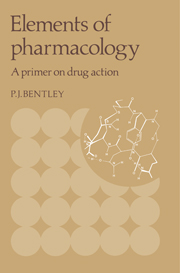Book contents
- Frontmatter
- Contents
- Preface
- 1 Introduction
- 2 Scope of pharmacology
- 3 Where do drugs come from?
- 4 The names of drugs
- 5 Techniques and methods of pharmacology
- 6 Absorption, distribution, and elimination of drugs; pharmacokinetics
- 7 The nature of responses to drugs
- 8 Receptor theory
- 9 Relationship of chemical structure to biological activity
- 10 Roles of the cell membrane in responses to drugs
- 11 Clinical aspects of the actions of drugs
- 12 Conclusion
- References
- Glossary of drugs named in the text
- Index
6 - Absorption, distribution, and elimination of drugs; pharmacokinetics
Published online by Cambridge University Press: 29 January 2010
- Frontmatter
- Contents
- Preface
- 1 Introduction
- 2 Scope of pharmacology
- 3 Where do drugs come from?
- 4 The names of drugs
- 5 Techniques and methods of pharmacology
- 6 Absorption, distribution, and elimination of drugs; pharmacokinetics
- 7 The nature of responses to drugs
- 8 Receptor theory
- 9 Relationship of chemical structure to biological activity
- 10 Roles of the cell membrane in responses to drugs
- 11 Clinical aspects of the actions of drugs
- 12 Conclusion
- References
- Glossary of drugs named in the text
- Index
Summary
When a drug is administered, it will usually enter the circulation and be rapidly distributed to the remainder of the body fluids and tissues. To be therapeutically effective, it must reach and maintain a certain minimum concentration in the plasma. If, however, a very high level is attained, it may result in toxic effects. The processes involved include the absorption of drugs into the circulation, their transport and distribution to the tissues, and the processes that control their metabolism and elimination from the body. The role of these processes in relation to the final effects of the drug is summarized in Figure 1.
Administration and bioavailability of drugs
Considerations involved in drug administration
The method of administering a drug is dictated by a number of considerations.
Chemical nature of the drug. The chemical nature of drugs is of primary importance. Thus, proteins and polypeptides will be inactivated by the digestive juices and will be ineffective when given by mouth. Absorption across the gastrointestinal mucosa will be favored if the molecules are lipophilic. Despite such absorption, some drugs are still relatively ineffective because when they pass into hepatic-portal circulation and go to the liver, they may be inactivated there. In some cases such as that of the steroidal sex hormones, this process of metabolism can be so effective as to nearly destroy all of the activity before the drug enters the general circulation. Such preparations can, however, often be chemically modified so as to block their metabolism by the liver.
- Type
- Chapter
- Information
- Elements of PharmacologyA Primer on Drug Action, pp. 12 - 39Publisher: Cambridge University PressPrint publication year: 1981



